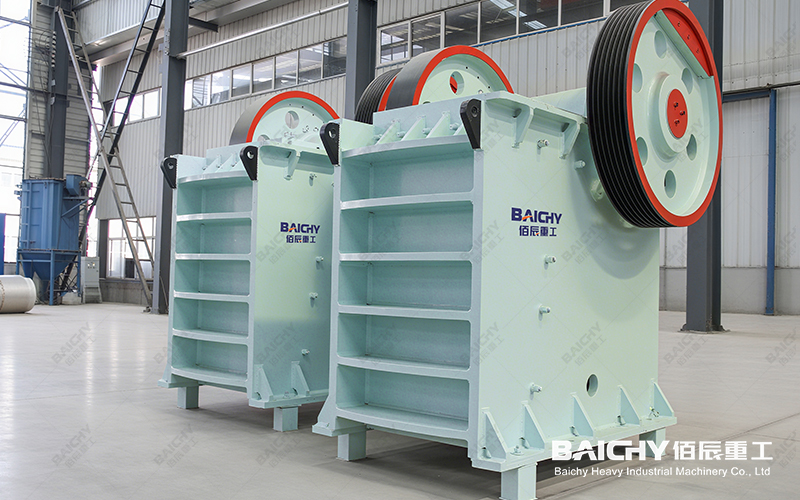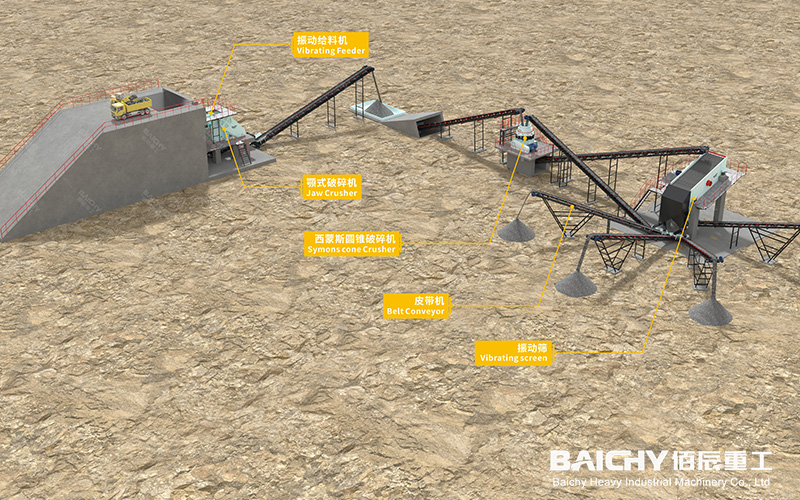
In numerous industrial sectors such as ore crushing, construction waste treatment, and cement production, precise control of output particle size is a key indicator of production process efficiency.
When your production needs are focused on finely crushed materials below 5 mm, a high-efficiency, reliable equipment with flexibly adjustable output particle size is essential.
Baichy will delve into a star product that perfectly meets this need—the dual-stage crusher with an adjustable output particle size of 0-5 mm.
I. What is a dual-stage crusher? Why can it provide "two-stage" power?
A dual-stage crusher, as the name suggests, is a high-efficiency pulverizing device that employs two crushing processes connected in series within the same machine body. It abandons the traditional single-stage crusher's "one-step crushing" extensive mode, achieving integrated "coarse crushing + fine crushing" through coordinated operation.
Its core working principle is as follows:
• First-stage crushing (coarse crushing): Material enters the first crushing chamber through the feed inlet and is initially crushed into smaller pieces by the violent impact of high-speed rotating hammers.
• Secondary Crushing (Fine Crushing): The material from the primary crushing stage immediately enters the secondary crushing chamber under the influence of gravity and the rotor. Here, it undergoes more intensive and precise hammering and grinding until the desired fineness is achieved.
This "pision of labor and cooperation" model results in crushing efficiency far exceeding that of single-stage equipment, lower energy consumption, and more effective control over the particle size of the final product.

II. Core Technology: How to Achieve Precise Particle Size Adjustment of 0-5mm?
"Adjustable discharge particle size" is the biggest highlight of this equipment. Its flexibility mainly relies on the following two key designs:
1. Adjustable Grate Screens (Core Component):
At the bottom of the secondary crushing chamber, a set of special grate screens is installed. The gap width between these screens directly determines the maximum particle size of the discharged material.
◦ Increasing the gap: The discharge particle size becomes coarser, and the output is relatively increased.
◦ Reduced Gap: The output particle size becomes finer, ensuring that all material larger than the set value (e.g., 5mm) remains in the chamber for further crushing until it reaches the required size before being discharged.
Through simple mechanical adjustments, operators can easily set the screen gap to any target value between 0mm and 5mm, allowing for seamless switching from fine powder to fine granules.
2. Synergistic Effect of Wear-Resistant Hammers and Impact Liners:
In addition to the screen, the material in the chamber is subjected to repeated impacts and friction between the high-speed hammers and the impact liners. Adjusting the gap between the hammers and liners helps control the crushing effect and particle shape, ensuring uniform output, fewer angular particles, and higher quality.
III. Significant Advantages: Why Choose It?
• Multi-functional, Simplified Process: One machine replaces the crushing process that originally required two machines (e.g., jaw crusher + fine crusher), significantly saving on equipment investment, floor space, and labor costs.
• Precise particle size and high yield: Adjustable fine range of 0-5mm meets the stringent particle size requirements of industries such as chemical, building materials, and metallurgy, significantly reducing over-grinding and improving the target yield.
• High efficiency and energy saving, low operating cost: The dual-stage tandem crushing process results in higher energy utilization, reducing total energy consumption by more than 30% compared to traditional two-stage crushing production lines.
• Overload protection, safe and reliable: The equipment is typically equipped with a hydraulic opening device that automatically releases when encountering uncrushable materials (such as iron blocks), effectively protecting core components from damage.
• Strong adaptability, not afraid of wet materials: The unique screenless design (for certain models) prevents clogging even with slightly high material moisture content, ensuring continuous production.
IV. Wide range of applications
This dual-stage crusher with adjustable fine output is ideal for the following fields:
• Building materials industry: Fine crushing of raw materials such as cement clinker, limestone, and shale.
• Mining Industry: Fine crushing of materials such as coal gangue and ore.
• Environmental Recycling: Recycling and reusing construction waste, bricks, tiles, and concrete, crushing them into recycled aggregates.
• Fertilizer Industry: Crushing raw materials to a fineness suitable for granulation.
• Other Fine Processing Fields: Any crushing operation requiring materials to be controlled to a size below 5mm.
In today's pursuit of refined and efficient production, a two-stage crusher with an adjustable output particle size within the 0-5mm range is not only a powerful tool for improving product quality but also a strategic choice for reducing overall operating costs and enhancing market competitiveness. With its unique two-stage crushing structure and precise adjustment capabilities, it is becoming an indispensable core equipment in modern industrial crushing processes.
If you are looking for solutions for fine crushing of materials, consider learning more about two-stage crushers; they may be the key to propelling your business towards greater precision.










